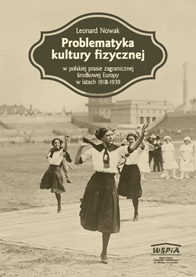Leonard Nowak, Problematyka kultury fizycznej w polskiej prasie zagranicznej środkowej Europy w latach 1918-1939
From the review by Prof. Bernard Woltmann, PhD
The history of Polish diaspora physical culture, formally initiated with the creation of the first Sokół (Falcon) nests in Chicago (USA) in 1887 and shortly thereafter in Europe (Odessa 1888, Berlin 1889), is already quite well reflected in the native historiography of physical culture. Existing literature illustrates the development of this movement around the world, especially in Central Europe. Some publications reveal the conditions of its evolution, while others focus on organizational activities.
However, none of the books meet the criteria of a synthesizing work. They are generally markers for further research. This is also true for publications about the Polish press abroad. Among these, there are no works depicting the role of newspapers and journals in the fields of physical education, sports, tourism, and other forms of physical recreation in the Polish diaspora, including Polish youth abroad.
Therefore, it is commendable that Dr. Leonard Nowak has undertaken this challenge and decided to present the results of his exploration in a partial (limited to Central Europe and the interwar period) monograph on this issue. This initiative deserves recognition.
Selected excerpts from the book
"The fate of Poland and the conditions under which it regained independence led to approximately 2.5 million Poles living outside the borders of the Republic (in its shape from 1913-1922) in neighboring countries. These included both inhabitants of lands that were part of Poland at the dawn of its statehood, such as Silesia, Krajna Złotowska, Powiśle, Warmia, and others, as well as colonists – settlers from the medieval period or the era of eastern expansion in the 15th-17th centuries, including also the Polishized foreigners (from Lithuania, Belarus, Ukraine)."
"Polish emigration primarily moved to countries that were at a higher level of civilizational and economic development, where other national groups of earlier emigrants had often already settled. Those arriving at their new place of residence encountered different working and living conditions. In Europe, they were mainly seen as cheap labor, which, after completing certain tasks, would return to their old place of residence, while only a small part would remain and merge with the dominant majority in the area."
"It should be noted that contemporary Polish press outside the country is an important source for understanding the history of Poles abroad. It contains a wealth of facts about Polish life, reflects the situation of the Polish population, the moods prevailing among them, the political and ideological directions that the leaders of Polish organizations attempted to impart to 'national work.'"
"Editorial offices of Polish newspapers and journals faced various types of political and legal pressures in their activities. This affected the forms and contents of publications and was also evident in the topic of physical culture, which was an important area of Polish organizations' activities. Physical education, sports, and tourism were to play a significant role in preventing Polish youth from joining foreign national organizations."
"The birth of modern sports movement in its national forms and in international cooperation coincided with the full development of the capitalist economic and political system. The rich traditions of this movement provided a powerful educational influence on Polish society. The Polish sports movement emerged during the partitions. In the activities of gymnastic societies or sports clubs, physical fitness was treated as one of the important elements of patriotic and independence work."

